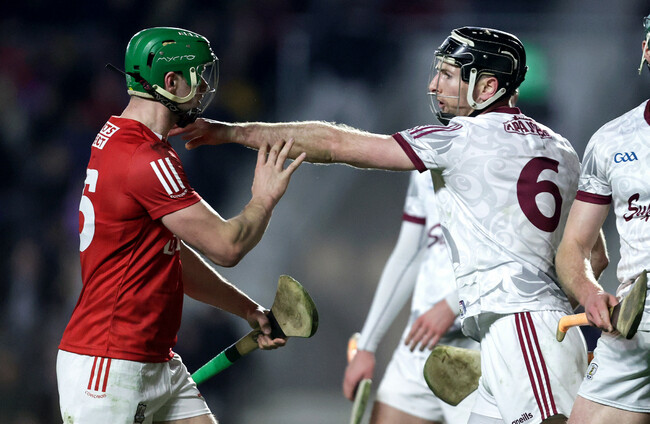CORK WILL WALK into Thurles this Saturday thinking they can find joy from turning over Galway’s long puck-outs.
Since their losses to Limerick and Clare in the opening rounds of the Munster Championship, Kieran Kingston’s men have used their set-up on the opposition’s puck-out as a launchpad.
The combination of Galway’s current long puck-out and Cork’s set-up on the opposition’s restarts could lead to a perfect storm.
Galway’s issue
The issue for the Tribesmen is that their wing-backs and goalkeeper are not in sync when the ball is being hit long from the restart.
Galway’s wing-backs actively look for the puck-out from Eanna Murphy or try to position themselves to receive a pass from a corner-back if the restart goes short.
The problem for Galway is when the goalkeeper decides that a short option to the corner-back or a ball to the wing is not viable. There is no communication between the goalkeeper and half-backs to indicate that the ball is going long which would allow the half-back to push up on their wing forward.
The opposition’s half-forwards gain a massive head start to the breaking area. This gives the opposition an extra player on the break. It allows the opposition to get player free for several seconds and have an option as an out ball if the Galway puck-out is turned over.
If this type of scenario continues it will play into Cork’s hands as their defence of the opposition’s puck-out is built on their six forwards covering space off behind them. This means that the opposition’s goalkeeper is unable to pick out the opposition player behind them as the wing-forwards have trust in their corner-forward to cut out the option to the half-back.
The Rebel’s wing-forwards can drop deep into the opposition’s half of the field and get heavily involved in the play.
Tipperary had a similar issue on their long puck-out and Kieran Kingston’s team seriously exposed it effectively, scoring 0-6 from the opposition’s restarts.
Cork’s set-up
When the opposition delivers the ball long off the puck-out, the side the ball is delivered down will see the Cork wing-forward funnel back at pace to get underneath the break which gives them an extra player in this area. This allows Cork to bring their own type of intensity to the game, but it’s built on having an extra player in these scenarios.
There is another layer to Cork’s set-up on the opposition’s puck-out which Galway must take care of and it is what happens on the opposite side.
On the opposite side of the pitch Cork’s corner-forward will drop out to the wing-forward position and their wing-forward will drop into midfield. This causes confusion in a defence if they are not prepared. A goalkeeper will want the corner-back to not follow his man out which gives the team an extra body in the full-back line while the wing-back may be unsure whether to follow the wing-forward into midfield.
Against Tipperary, Conor Lehane was able to drift in between the two defensive lines of the pitch and pick up deliveries after Cork had turned over the long puck-out.
The platform to attack is set-up by the Cork wing-forward winning the break from the long puck-out.
This allowed Ciaran Joyce to pick out Lehane on the opposite side of the pitch as the Tipperary backs were unsure who was picking up who. Despite Tipperary having an extra defender in their half, the movement from Cork had confused the defence and there was no benefit to having the extra player.
Lehane winning possession from Cork turning over the puck-out
This puck-out highlights the dangers for Galway if they are not in sync on their long puck-out as Cork effectively made three of the Tipperary defenders redundant in the game.
Galway need to change
If Galway do not address their wing-back’s positioning on their long puck-out it could spell the end. This issue can be an energy sapper.
The effect this puck-out can have on wing-backs is that they are caught in no man’s land and they go chasing their man up the field when the ball is in the air. If we analyse Padraic Mannion’s movement for Billy Ryan’s score off a Galway puck-out and how he had to engage in energy-sapping movement.
Kilkenny win the break from Galway’s long puck-out and Mullen is still free for an out ball as Mannion is still making up the ground.
Adrian Mullen receives the out ball from the turnover and Mannion is unable to get close to the Ballyhale man. The Galway player’s mindset switches from chasing up the field to running back towards his own goal in order to double up with his corner-back.
Mannion is unable to affect the play and the ball is won by a Kilkenny forward and played across to the pitch to Billy Ryan who scores. Padraic Mannion’s recovery run ended up with him being the last line, but he put in no tackle or had any influence on the game.
For Mannion he watched a Galway puck-out hit up his wing which forced him to sprint up the pitch, Kilkenny have turned over the puck-out and Mannion’s man gained possession. A delivery has been hit up Mannion’s wing and he has had to make a sprint back inside his 21-metre line which still results in him having no influence and Kilkenny scoring a point.
For the Ahascragh-Fohenagh man, he has made energy-sapping runs and Kilkenny have generated a score from his side of the pitch.
For the Galway forwards and the team in general, losing possession can give off the psychological effect that they are not working hard enough, they are looking around to see who is not picking up an opposition player and it’s frustrating when the forwards are chasing opposition players when they are outnumbered.
All of this is coming from Galway having possession with their goalkeeper but there is an easy fix to the issue which can have serious effects on a team’s performance.
What Galway need to do
Galway need to do several things on their puck-out to curb the influence of the Cork team.
- When Eanna Murphy goes long on his puck-out there needs to be some sort of non-verbal communication which allows Padraic Mannion and Fintan Burke to push up on their wing forward.
- On the opposite side of the pitch when the ball is played long off the restart, the Galway players must have clarity in relation to where they are to position and who they are to pick up.
A possible solution is to keep their corner-back inside their 45-metre line and allow the Galway wing-back to pick up the Cork wing-forward moving out the pitch.
The Galway wing-forward on the opposite side of the puck-out should try to pick up Cork’s wing-forward dropping deep, and the Galway corner-forward needs to cover the Rebel’s wing-back.
This will allow Galway to bring their physicality to the game
If Galway do this to Cork on Saturday it will mean they will have equal numbers where the ball is landing and the Shefflin’s team can use their physicality to outmuscle Cork.
The benefits to Galway could be two-fold as it would provide Cork with a gut check as their wing-forwards will be unable to win loose ball uncontested on the break. It will hamper their ability to work the ball around their defence to set up attacks and gain scores from the opposition puck-out.
This will suck Cork into a dog fight with lots of rucks in this area of the pitch and if Galway have equal numbers this will be a true test of Cork’s ability to win possession in ruck situations. The one question mark over this Cork team is in relation to their ability to win rucks and break out of these situations to attack when they are up against a highly physical team like Galway.
Conclusion
If Galway allow Cork the freedom, Kieran Kingston’s men will hurt them on the scoreboard. If Shefflin’s men can box clever in these areas, they should back themselves to win a dog fight.
If the game does become a battle with a packed middle third it will provide the perfect test for Cork. This is a test they need to pass, and it would help build more confidence in their team’s ability to deal with physical teams. This can instil the confidence they will need going into a possible semi-final against Limerick.





















Don’t know if this lad is up to it would love to see Mark Travers, caomhin kelleher or Gavin bazunu get loan moves or start starting for their first teams.But that’s highly unlikely for kelleher or bazunu so a loan is probably needed. But I’d say Travers is better than Ramsdale at Bournemouth imo.
@James Mockler: apart from his debut,Travers has mad so many errors when given a chance,Ramsdale is a decent keeper.
@Nic Antonio: tbf travers has made mistakes but so has Ramsdale one that springs to mind is against Leicester I think vardy lobbed him from 35 yards. But I think play Travers as much as Ramsdale and you’ll potentially have a better keeper in the long run.
@James Mockler: O’Hara is a good keeper and playing first team football unlike Travers and Gavin is miles away from playing for Irish senior team.